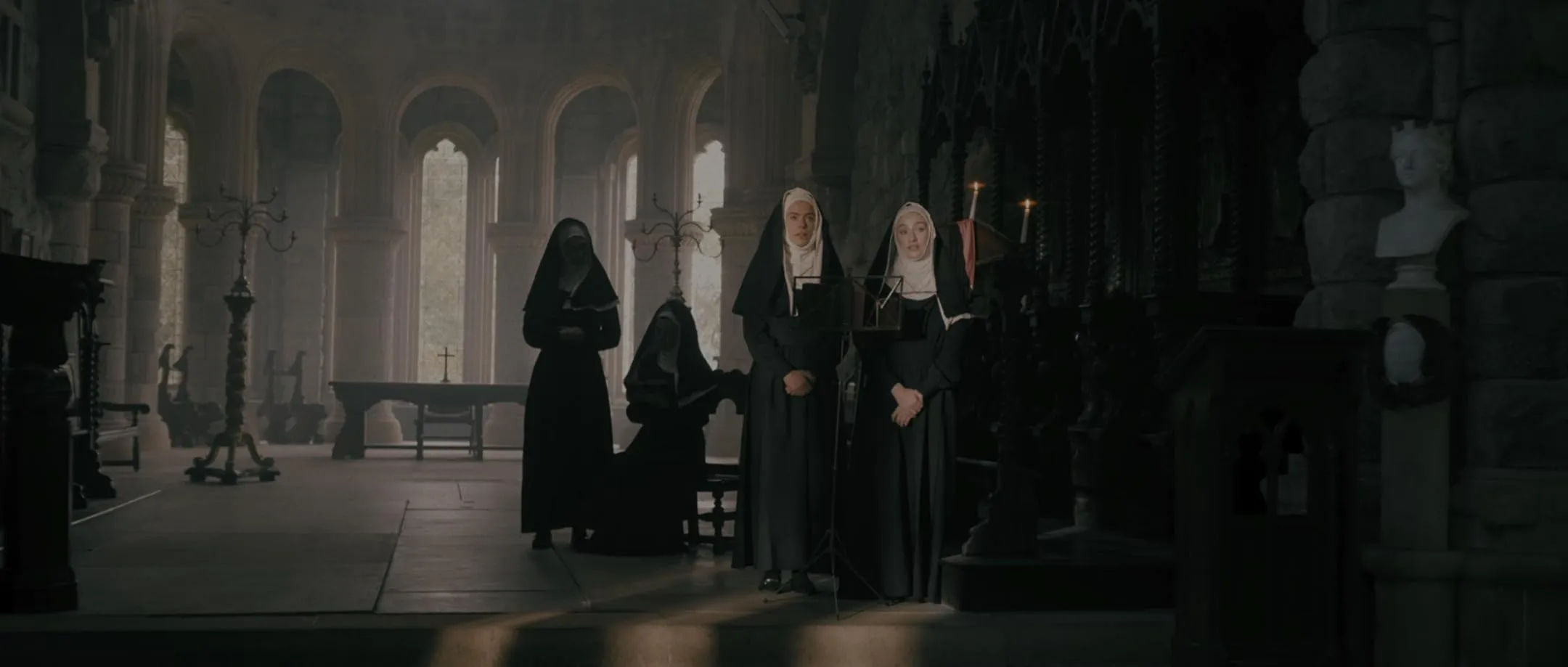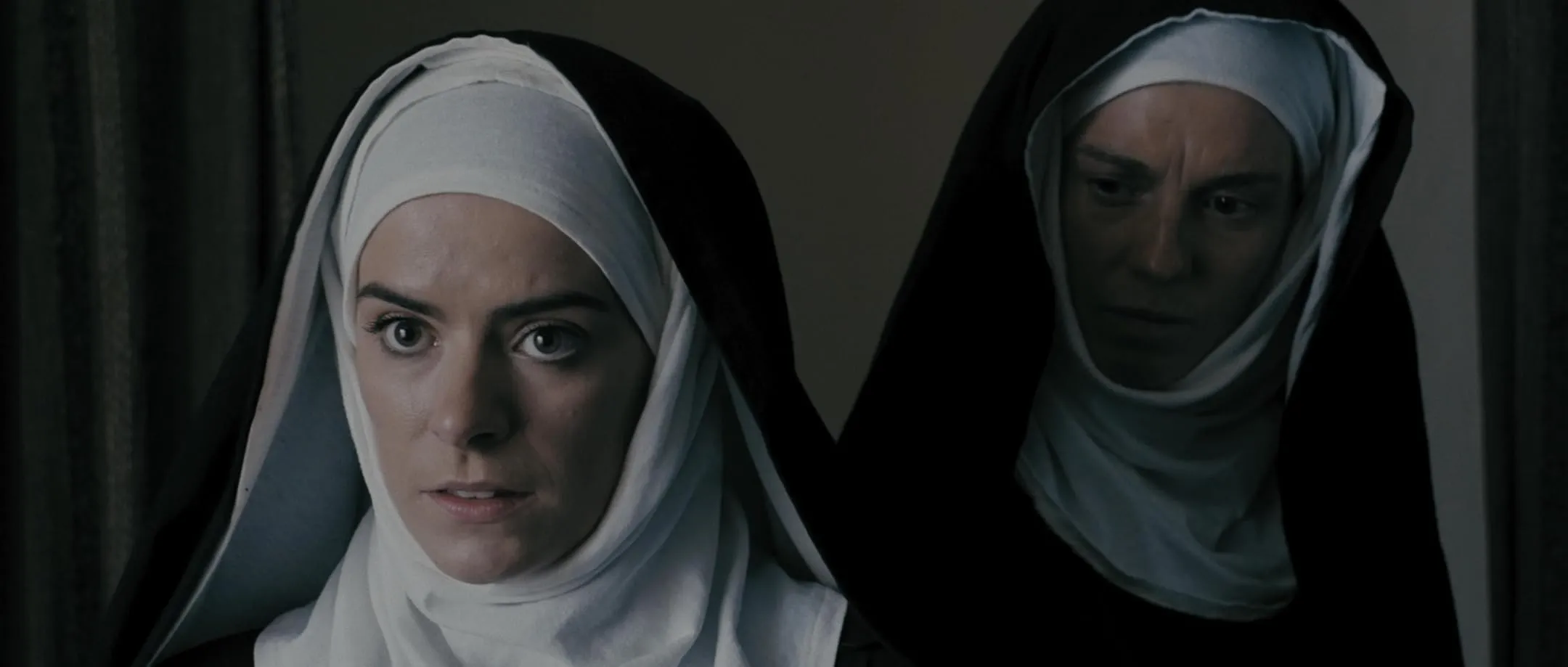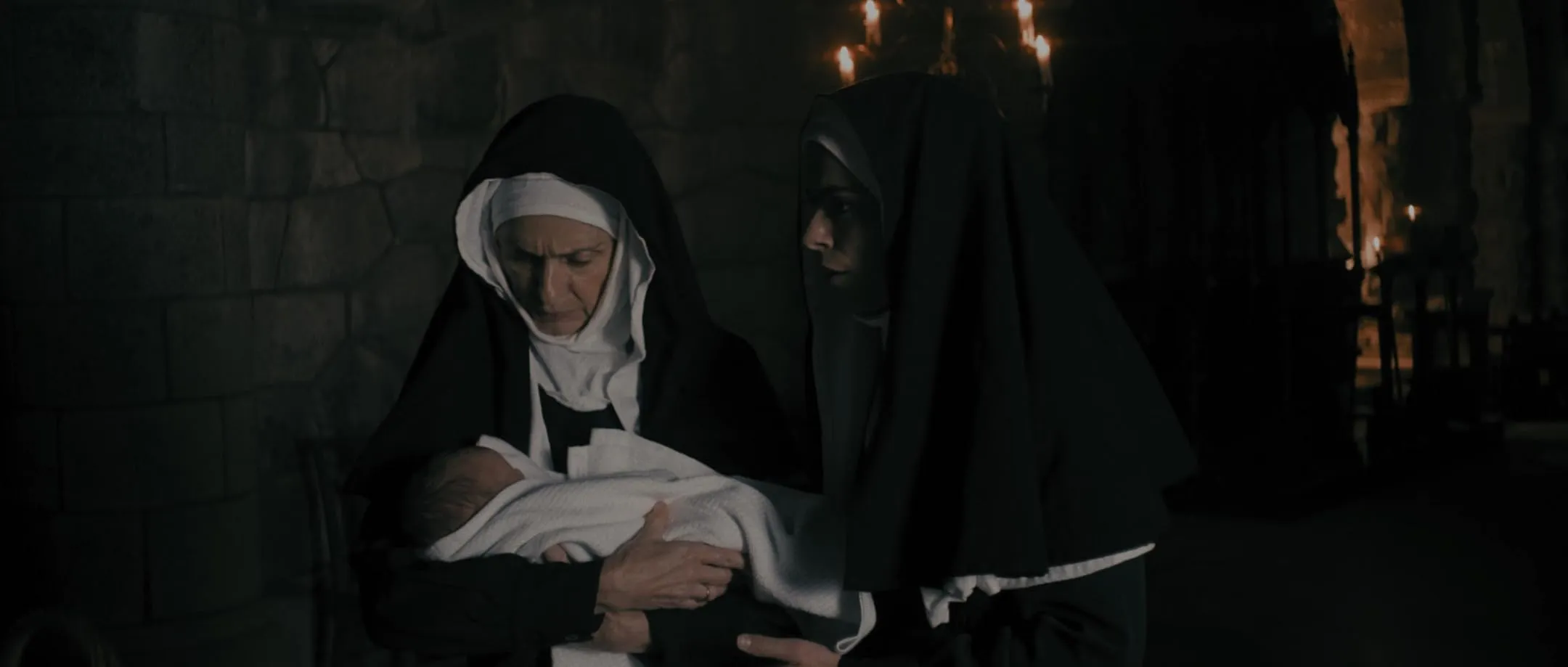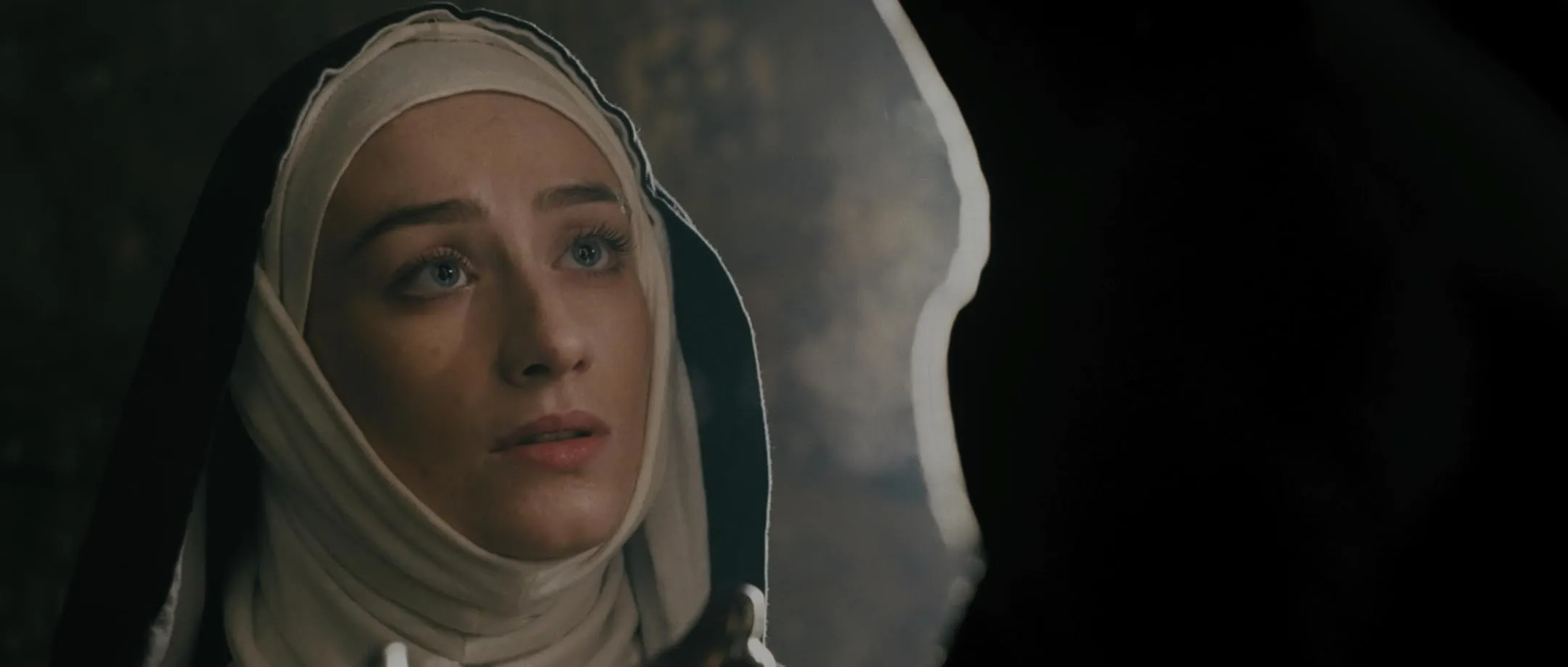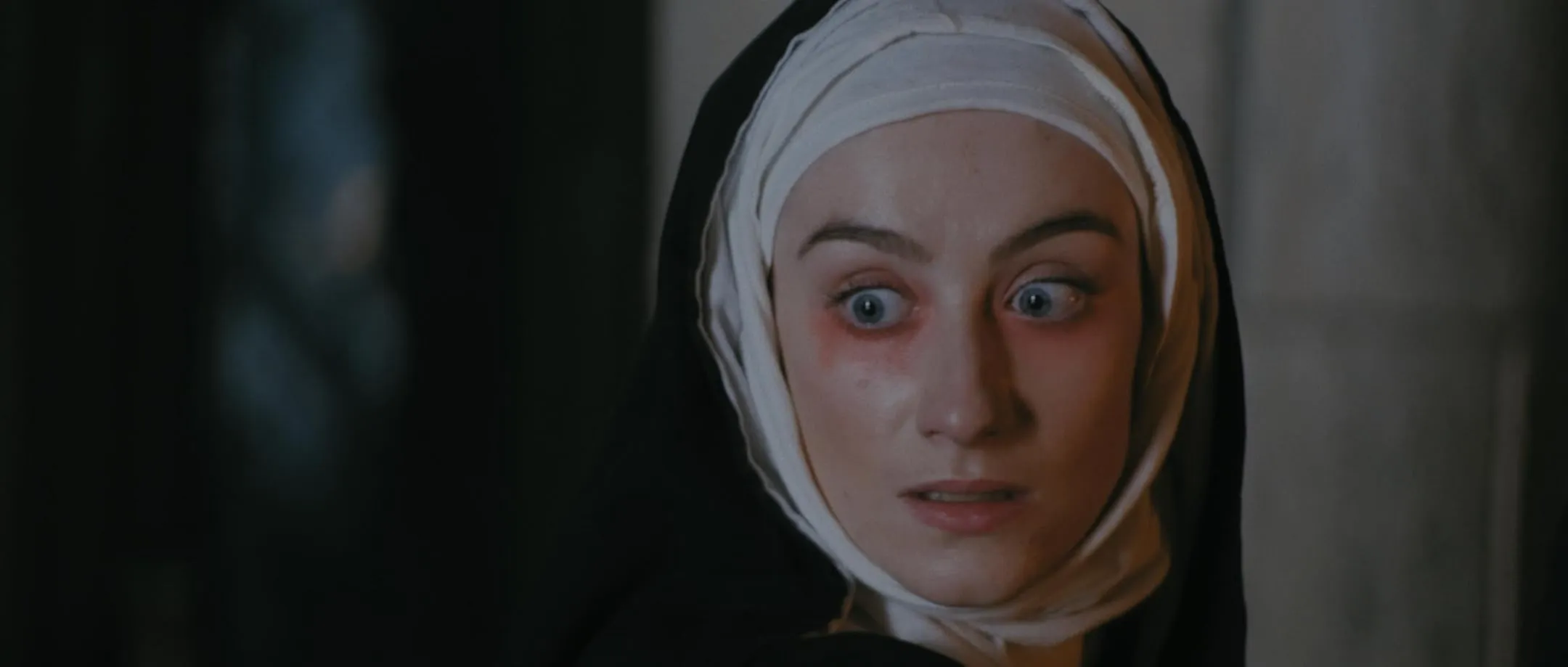Amid the salt‑gnawed cliffs of a wartime Scottish isle stands St Augustine’s, a convent whose silent walls betray more than whispered prayers. The film opens in 1942, as a storm‑tossed basket—its fragile cargo an abandoned neonate—arrives at the sisters’ threshold, igniting an unseen fissure between devotion and dread.
Gothic horror intertwines with nunsploitation’s audacious flair, each habit‑clad figure cast in chiaroscuro, their faces half‑lit by candle and half‑claimed by shadow. Directors Nathan Shepka and Andy Crane, drawing on Tom Jolliffe’s pen and Shepka’s own wartime scars, sculpt an atmosphere of low‑budget poetry: wind howls through empty corridors, punctuated by a demonic lullaby that slithers into the soul.
The film wears its retro homage like a moth‑eaten veil, winking at 1970s cult cinema even as it plumbs existential depths—what faith endures when innocence itself harbors an abyss? With occasional campy flourish—a snarling wolf that seems more friend than predator—the movie cloaks its philosophical pulse beneath ritual and ruin, inviting us to question whether salvation lies in steadfast belief or in the courage to face the darkness within.
Stone, Shadow, and Storm
On a windswept isle where gray skies hang like verdicts, the years 1942 to 1944 press down on St Augustine’s convent with relentless weight. Imagine walls built by hands hardened by prayer but softened by fear; the sisters’ vow of seclusion collides with wartime isolation to forge a crucible of trembling psyches. How does faith endure when each thunderclap resonates like distant artillery, each empty pew an echo of absence?
Within those stone corridors, candles gutter in trembling pools of light. Vaulted chapels shelter both hope and doubt; every wavering flame carves out tendrils of shadow that cling to the sisters’ memories. Outside, the wind scours the moor until it seems to howl with a voice older than grief itself—a wolf’s unthreatening trot becomes a specter at the door, setting the stage for the baby’s arrival.
The film’s frames favor stark contrasts: a handheld camera that lingers too close in narrow passages shifts suddenly to wide panoramas where the convent looms solitary amid heaving seas. Color bleeds toward ashen iron and bone; every hue surrenders to muted despair. Light and dark occupy the same space, forcing viewers to seek meaning where neither fully claims dominion.
At first, time drips slowly, each second stretching until nerves fray. Then, with the infant’s arrival, tension coils—footsteps grow urgent, breaths shorten, and silence becomes a palpable weight. Ambient creaks, distant thunder, the hush after a whispered prayer: these sounds form a stillness that unsettles deeper than a scream.
Anatomy of Unrest
The film plunges us into its heart with a wolf’s breath on the nape of the neck—a brief chase through moonlit heather that feels as much fable as omen. In that cold open, danger is neither spoken nor seen in full; it is suggested by rustling leaves and the animal’s silent intent. By the time the sisters re-enter their stone‑walled sanctuary, their day‑to‑day chants and ritual wash over us in measured rhythm, as though their piety might stave off the chaos beyond.
Then comes the basket: a cloaked figure leaves behind an infant whose arrival is freighted with ancient echoes of abandonment and destiny. The nuns’ decision to tend this child—compassion or compulsion?—sets in motion a slow‑spiraling dread. Whispers seep into confessionals, urging mercy or self‑destruction in the name of “His child,” and fractures appear: solidarity fractures like stained glass under siege.
Violence unspools in the climax, sisters turned aggressors in dim corridors, one locked away in a cold cell of her own making; the convent becomes both stage and victim. When a horned puppet baby emerges, the story abandons its psychological moorings for full‑throttle horror. Yet even as gore drips and screams echo, uncertainty lingers—have we witnessed evil externalized, or only the sisters’ own despair given form? The final frames offer no neat answer, leaving judgment suspended in the flicker of dying candles.
Faces of Faith and Fracture
Maryam d’Abo’s Mother Superior moves with the quiet authority of one who has weathered storms of both nature and spirit. In her eyes, devotion flickers like a lone candle buffeted by unseen winds. When she cradles the infant, her gentle blessing carries the weight of every vow she has ever taken; yet as the sisters’ harmony unravels, that same tenderness becomes a battleground of doubt and duty. In the scene where she confronts the rising chaos—habits dusted with ash and guilt—d’Abo embodies the paradox of compassion hardened by necessity.
Amber Doig‑Thorne charts a chilling evolution in Sister Agnes, her voice soft as prayer in early scenes, then sharpening into frantic accusation. When she is hauled away into solitary confinement, her whispered laments twist into mantras of dread, as if each syllable drags her further from sanctity. The descent feels inevitable: faith warped by fear becomes an oracle of destruction, and Agnes stands at its trembling mouth.
Michaela Longden’s Eleanor offers an unsettling counterpoint. She nurses her doubts with stolen swigs of wine, a skeptic in a sea of piety. Her interactions with Daniel shimmer with mutual loneliness—each seeks solace in another’s exile. She flirts with irreverence, yet the line between clear‑sightedness and fatal cynicism blurs in her gaze.
Valerie, Lucy, and Annalise arrive as distinct patterns in a mosaic of belief: the zealot, the secret firebrand, the maternal guardian. Their bodies may be draped in identical habits, but they surrender to—or resist—the basket’s curse in ways that feel eerily personal.
On the margins, Nathan Shepka’s Daniel carries the residue of combat in every tremor, his restrained longing a mirror to the nuns’ own buried desires. Paul Barber’s Amos, gentle yet immovable, anchors the story even as the convent drifts from harmony into savagery.
Together, this ensemble performs a ritual of collapse, their unity dissolving in echoes of ancient chants—each voice offering a glimpse of hope or horror as the fragile order of their world fractures before our eyes.
Architecture of Fear and Faith
In their shared vision, Nathan Shepka and Andy Crane erect a slow‐burn rhythm that feels less like conventional scares and more like a confession whispered in a hollow crypt. They embrace the film’s shoestring means—each cut, each lingering shot affirms a devotion to atmospheric immersion. There is sincerity in their craft, yet they allow camp’s sly wink to surface when the walls tremble under dueling impulses of piety and panic.
Cinematographer Andy Crane composes frames as if painting with absence. A pair of cherubim gaze down from a canvas as sisters unravel below, their silent judgment cast in spectral chiaroscuro. The camera drifts in measured glides through narrow cloisters, then jolts in abrupt bursts as horror peaks—an unsettling dance between restraint and rupture that mirrors the soul’s unsteady pulse.
Costumes and sets breathe period authenticity: habits threaded with subtle wear, wooden pews scarred by generations of penance, and a storm‑lashed exterior that seems to claw at the stone façade. Candles gutter upon altar cloths, their wax pooling like tears, while rusted relics of war—helmets, ration tins—linger in shadowed corners, reminders that faith and conflict are never far apart.
When the wolf lolls playfully before the nun, its harmless wag undercuts our expectations, a brief slip that reminds us menace is often imagined rather than real. Later, the horned infant puppet emerges—its crude artistry both arresting and oddly vulnerable, as if the devil himself had enlisted a toymaker’s hands. Practicality and illusion entwine, inviting us to question whether fear resides in what we see or in the gaps our minds create.
Throughout, nods to vintage horror traditions surface like footnotes in a marginalia of dread: a Gothic arch here, a whisper of Hammer’s hymns there, even the economy of British “quota quickie” filmmaking echoing in every creaking floorboard. This interplay of homage and invention casts the convent not merely as a setting but as a living text, ripe for our darkest interpretations.
Echoes of Dread
Sound in The Baby in the Basket feels less like accompaniment and more like a spectral presence—an unseen sister whose heartbeat underpins every scene. Organ drones hum beneath the surface, vibrating like the toll of a judgment bell, then give way to sudden crescendos that cleave through silence with surgical precision. Between these waves, unsettling quiet stretches until it becomes its own instrument, forcing us to confront the void that lies at the heart of faith.
Ambient effects—wind rattling leaded windows, the slow creak of ancient floorboards—sculpt the convent into a living mausoleum, each groan of timber a whispered confession. Demonic murmurs curl through corridors, twisting Scripture into incantation, while distant screams and echoing footsteps dissolve the boundary between psychological torment and supernatural intrusion.
Editing moves with philosophical deliberation: long, contemplative takes invite reflection, then snap‑cut bursts of violence shatter the calm like a frayed nerve. These transitions blur time’s compass, leaving us uncertain whether the real horror resides in what we hear—or in the silent space between one cut and the next.
Sanctum of Contradictions
Here, faith and evil merge into indistinguishable specters. The sisters’ devotion—a fragile covenant tested by whispered commands—casts the infant alternately as a Christ‑figure bearing salvation and as a demonic harbinger demanding sacrificial obedience. In this tension lies a meditation on theodicy: can belief endure when innocence itself conceals a razor’s edge?
Isolation acts as both crucible and prison. St Augustine’s, cut off by war and storm, becomes a theater of collective delirium. Are the horrors that unfold born of an external malice, or do they spring from the sisters’ own repressed fears and desires? The convent’s stone walls swallow certainty, leaving only the question of whether evil lives in shadows or in our unspoken impulses.
Nunsploitation tropes—habit stripping as ritual undressing, forbidden yearnings, infanticide’s dark whisper—surface without full parody. The film honors its lineage while acknowledging the discomfort these images provoke, avoiding pastiche in favor of uneasy sincerity.
A “quota quickie” aesthetic seeps through every rough edge, trading polish for raw intensity. Camp pulses beneath the candlelit gloom, yet mood never collapses into mere irony. In this convergence of homage and invention, The Baby in the Basket stakes its claim amid an indie horror revival—one that probes how belief can fracture when confronted with its own shadow.
Full Credits
Directors: Andy Crane, Nathan Shepka
Writers: Tom Jolliffe (screenplay), Nathan Shepka (story)
Producers and Executive Producers: Gary Collinson, Tom Jolliffe, Nathan Shepka, Amie Collinson, Shane Ryan-Reid, Phil Wheat, Kevin Haldon
Cast: Amber Doig-Thorne (Agnes), Michaela Longden (Eleanor), Elle O’Hara (Valerie), Lisa Riesner (Lucy), Maryam d’Abo (Mother Superior), Paul Barber (Amos), Nathan Shepka (Daniel), Annabelle Lanyon (Annalise), Tim Spriggs (Satan, voice), David Rogerson (German Soldier)
Director of Photography (Cinematographer): Andy Crane
Editor: Nathan Shepka
Composer: Christopher Belsey
The Review
The Baby in the Basket
The Baby in the Basket plumbs the fragility of belief beneath B‑movie trappings, conjuring an atmosphere that lingers long after the credits roll. Its austere visuals, committed performances, and philosophical undercurrents elevate the modest effects and familiar tropes into something quietly unsettling. Though at times the narrative momentum stalls, the film’s willingness to let dread ferment within stone walls and whispered prayers stakes its place in modern gothic horror.
PROS
- Evocative atmosphere that lingers beyond the screen
- Committed performances, especially from d’Abo and Doig‑Thorne
- Thoughtful exploration of faith under pressure
- Striking use of convent setting and period detail
- Blend of sincerity and playful camp
CONS
- Pacing slows noticeably in the first act
- Budgetary limits show in the demon baby design
- Narrative clarity sometimes gives way to ambiguity
- Climactic shift to overt horror can feel abrupt









































